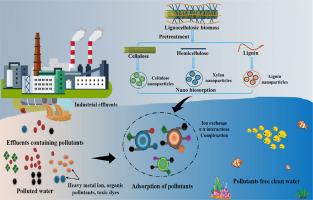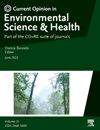木质纤维素废弃物的可持续纳米吸附剂:废水处理的绿色途径
IF 6.6
Q1 ENVIRONMENTAL SCIENCES
Current Opinion in Environmental Science and Health
Pub Date : 2025-09-04
DOI:10.1016/j.coesh.2025.100665
引用次数: 0
摘要
面对不断升级的水污染,开发创新和可持续的废水处理工艺已成为保护生态系统的必要条件。本文综述了纳米技术与木质纤维素材料的结合,以开发具有成本效益、高性能的废水处理纳米吸附剂。纳米结构的纤维素和木质素表现出增强的孔隙度、表面积和功能化能力,能够有效地去除包括重金属在内的环境污染物。综述了纳米纤维素/纳米木质素在去除水污染物方面的研究进展,探讨了纳米纤维素/纳米木质素去除水污染物的机理,并对其生命周期进行了分析。这些生物基纳米材料减少了环境影响,提高了资源效率,并支持可持续发展目标(sdg)。本文章由计算机程序翻译,如有差异,请以英文原文为准。

Sustainable nanoadsorbents from lignocellulosic waste: A green approach to wastewater treatment
In the face of escalating water pollution, the development of innovative and sustainable processes for wastewater treatment has become imperative to safeguard ecosystems. The current review explores the integration of nanotechnology with lignocellulosic materials to develop cost-effective, high-performance nanoadsorbents for wastewater treatment. The nanostructured cellulose and lignin exhibit enhanced porosity, surface area, and functionalization capabilities, enabling efficient removal of environmental pollutants, including heavy metals. The advancements in using nanocellulose/nanolignin for removing water pollutants and understanding the underlying mechanisms, as well as life cycle analysis, are discussed. These bio-based nanomaterials reduce environmental impact, improve resource efficiency, and support sustainable development goals (SDGs).
求助全文
通过发布文献求助,成功后即可免费获取论文全文。
去求助
来源期刊

Current Opinion in Environmental Science and Health
Medicine-Public Health, Environmental and Occupational Health
CiteScore
14.90
自引率
0.00%
发文量
92
审稿时长
114 days
 求助内容:
求助内容: 应助结果提醒方式:
应助结果提醒方式:


